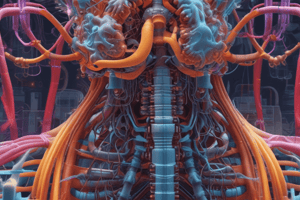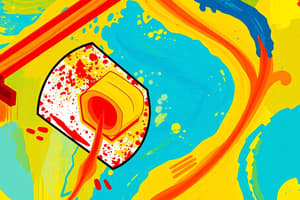Podcast
Questions and Answers
Which of the following assessment findings would MOST likely support a diagnosis of thoracic outlet syndrome?
Which of the following assessment findings would MOST likely support a diagnosis of thoracic outlet syndrome?
- ST-segment depression on the 12-lead ECG tracing
- Disappearance of radial pulses during expiration
- Bruits to both carotid arteries during auscultation
- Difference in blood pressure between the two arms (correct)
A patient with crushing chest pain has 3 mm of ST elevation in leads V1, through V4. What should you suspect?
A patient with crushing chest pain has 3 mm of ST elevation in leads V1, through V4. What should you suspect?
- Left circumflex occlusion
- Left anterior descending artery occlusion (correct)
- Right ventricular infarction
- Right coronary artery occlusion
What is a classic sign of atrial flutter?
What is a classic sign of atrial flutter?
- The presence of sawtooth F waves (correct)
- An irregular but consistent R-R interval
- A ventricular rate less than 100 beats/min
- A constant 2:1 conduction ratio
A decreased cardiac output secondary to a heart rate greater than 150 beats/min is caused by:
A decreased cardiac output secondary to a heart rate greater than 150 beats/min is caused by:
A delta wave is identified on a cardiac rhythm strip as a(n):
A delta wave is identified on a cardiac rhythm strip as a(n):
A major complication associated with atrial fibrillation is:
A major complication associated with atrial fibrillation is:
A pathologic Q wave is typically:
A pathologic Q wave is typically:
What is the most likely cause of right ventricular infarction?
What is the most likely cause of right ventricular infarction?
What type of episode is the advanced EMT student experiencing during IV skills practice?
What type of episode is the advanced EMT student experiencing during IV skills practice?
What is the primary concern for the 74-year-old male resident who is unable to move his head?
What is the primary concern for the 74-year-old male resident who is unable to move his head?
What is the most reliable indicator of significant energy dissipation by braking before a motor vehicle collision?
What is the most reliable indicator of significant energy dissipation by braking before a motor vehicle collision?
What characteristic of an entry wound indicates that the weapon was fired at close range?
What characteristic of an entry wound indicates that the weapon was fired at close range?
What is the primary reason for the paramedic's acute anxiety upon arriving at the scene of a motor-vehicle-versus-pedestrian incident?
What is the primary reason for the paramedic's acute anxiety upon arriving at the scene of a motor-vehicle-versus-pedestrian incident?
What is the correct treatment for the 74-year-old male resident who is experiencing symptoms related to Seroquel?
What is the correct treatment for the 74-year-old male resident who is experiencing symptoms related to Seroquel?
What is NOT a factor when considering transport of a trauma patient via helicopter?
What is NOT a factor when considering transport of a trauma patient via helicopter?
What is the primary concern for the elderly woman who is afraid of losing her independence?
What is the primary concern for the elderly woman who is afraid of losing her independence?
What is the primary focus when caring for a patient who experienced blunt abdominal trauma?
What is the primary focus when caring for a patient who experienced blunt abdominal trauma?
What is the correct initial management of a patient with a grossly deformed elbow?
What is the correct initial management of a patient with a grossly deformed elbow?
Which of the following is NOT a common sign or symptom of an acute pulmonary embolism?
Which of the following is NOT a common sign or symptom of an acute pulmonary embolism?
What should you suspect when discovering a rapidly expanding hematoma on the medial aspect of a patient's thigh?
What should you suspect when discovering a rapidly expanding hematoma on the medial aspect of a patient's thigh?
What is the primary goal when caring for a patient with blunt abdominal trauma?
What is the primary goal when caring for a patient with blunt abdominal trauma?
What is the correct management of a patient with a femur fracture?
What is the correct management of a patient with a femur fracture?
What is a common sign of an acute pulmonary embolism?
What is a common sign of an acute pulmonary embolism?
What is the correct initial management of a patient with blunt abdominal trauma?
What is the correct initial management of a patient with blunt abdominal trauma?
A patient's respiratory rate and depth have decreased, what should you do?
A patient's respiratory rate and depth have decreased, what should you do?
What should you suspect if a patient on a CPAP unit starts to deteriorate?
What should you suspect if a patient on a CPAP unit starts to deteriorate?
What is the classic presentation of chronic bronchitis?
What is the classic presentation of chronic bronchitis?
How many PVCs in a row are required to be considered a 'run' of ventricular tachycardia?
How many PVCs in a row are required to be considered a 'run' of ventricular tachycardia?
A patient complains of severe pain between his shoulder blades, which he describes as 'ripping' in nature. What should you suspect?
A patient complains of severe pain between his shoulder blades, which he describes as 'ripping' in nature. What should you suspect?
A patient is on high-flow oxygen via nonrebreathing mask and has an IV of normal saline in place. What should you reassess?
A patient is on high-flow oxygen via nonrebreathing mask and has an IV of normal saline in place. What should you reassess?
What should you do if a patient's CPAP unit is not functioning properly?
What should you do if a patient's CPAP unit is not functioning properly?
What is the primary concern for a patient with a history of emphysema?
What is the primary concern for a patient with a history of emphysema?
During CPR, how often should one breath be delivered?
During CPR, how often should one breath be delivered?
What is the maximum time a person should perform chest compressions at a time?
What is the maximum time a person should perform chest compressions at a time?
What treatment is NOT recommended for a 68-year-old man with an organized cardiac rhythm at a rate of 80 beats per minute and an absent carotid pulse?
What treatment is NOT recommended for a 68-year-old man with an organized cardiac rhythm at a rate of 80 beats per minute and an absent carotid pulse?
What should be the next action for a 6-year-old in ventricular fibrillation after an initial defibrillation and 2 minutes of CPR?
What should be the next action for a 6-year-old in ventricular fibrillation after an initial defibrillation and 2 minutes of CPR?
What should be done after a shock is delivered to a patient in pulseless ventricular tachycardia?
What should be done after a shock is delivered to a patient in pulseless ventricular tachycardia?
What should be done after a patient experiences a return of spontaneous circulation?
What should be done after a patient experiences a return of spontaneous circulation?
What should you do first if you witness an elderly man grab his chest and collapse to the ground?
What should you do first if you witness an elderly man grab his chest and collapse to the ground?
What is the goal of chest compressions during CPR?
What is the goal of chest compressions during CPR?
Flashcards are hidden until you start studying
Study Notes
Respiratory Emergencies
- In a patient with a long history of emphysema, if the respiratory rate and depth have decreased, begin assisting ventilations with a bag-mask and 100% oxygen.
- If a patient's respiratory rate and depth have decreased, consider inserting a nasal airway, applying a CPAP unit, and notifying medical control.
Cardiac Emergencies
- A "run" of ventricular tachycardia occurs if at least three PVCs occur in a row.
- A classic sign of atrial flutter is the presence of sawtooth F waves on a cardiac rhythm strip.
- A decreased cardiac output secondary to a heart rate greater than 150 beats/min is caused by decreases in stroke volume and ventricular filling.
- A delta wave is identified on a cardiac rhythm strip as a slurring of the upstroke of the first part of the QRS complex.
- A major complication associated with atrial fibrillation is clot formation in the fibrillating atria.
Medical Emergencies
- A patient with a severe pain between the shoulder blades, described as "ripping" in nature, and a history of noncompliance with antihypertensive medication, may have a difference in blood pressure between the two arms.
- A patient with a head cocked to the side and unable to move it, and a recent history of being placed on Seroquel, may require administration of 25 to 50 mg of diphenhydramine.
Trauma Emergencies
- A pathologic Q wave generally indicates that an acute myocardial infarction has occurred within the past hour.
- The most reliable indicator that significant energy was dissipated by braking before a motor vehicle collision is the presence of tire skid marks at the scene.
- A characteristic of an entry wound that indicates the weapon was fired at close range is the presence of tattoo marks from powder burns.
- To maximize a patient's chances of survival after blunt abdominal trauma, provide basic airway and circulation support at the scene, prompt transport to a trauma center, and IV fluid boluses as needed en route.
- A patient with a femur fracture and a rapidly expanding hematoma on the medial aspect of the thigh may have an arterial injury.
Pediatric Emergencies
- A 6-year-old child who remains in ventricular fibrillation after an initial defibrillation and 2 minutes of CPR requires defibrillation with 70 joules.
Resuscitation
- During cardiac arrest, compressions should be hard and fast, with full chest recoil between compressions.
- A patient who remains in pulseless ventricular tachycardia despite two shocks, a dose of epinephrine, high-quality CPR, and 300 mg of amiodarone requires administration of 150 mg of amiodarone.
- After approximately 6 minutes of attempted resuscitation, a patient who experiences a return of spontaneous circulation requires hypothermia treatment.
- If you witness a person collapse, proceed to assess the person and tell your partner to call 9-1-1 as you begin two-rescuer CPR if needed.
Studying That Suits You
Use AI to generate personalized quizzes and flashcards to suit your learning preferences.




